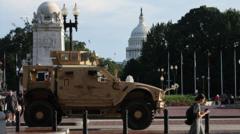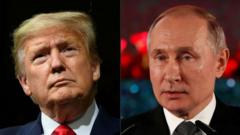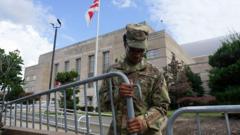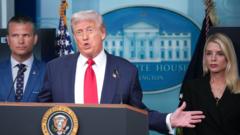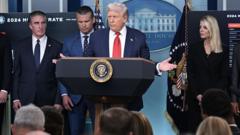The recent debate ahead of Canada’s general election brought the country's political landscape to a critical juncture, with major party leaders vying for public support while addressing pressing issues. Here are five significant takeaways from the event.
**Canada's Party Leaders Debate: Key Highlights and Implications for the Election**
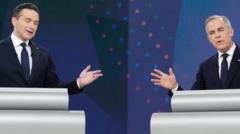
**Canada's Party Leaders Debate: Key Highlights and Implications for the Election**
This article delves into the pivotal moments from the recent TV debate among Canada's major political leaders, showcasing their strategies and stances amid a competitive election landscape.
The leaders of Canada's four prominent federal parties met for their second and final debate just days before the general election, but much of the focus turned to former U.S. President Donald Trump. Liberal leader Mark Carney, who has been leading in the polls, faced scrutiny over his connections to former Prime Minister Justin Trudeau, with opponents from the Conservative, New Democratic, and Bloc Québécois parties pushing to challenge his record.
**1. Trudeau's Legacy Lingers**
Carney's opponents did not hesitate to draw parallels between him and Trudeau, with Conservative leader Pierre Poilievre criticizing the past decade of Liberal governance. Poilievre's remarks about "the lost Liberal decade" centered on the high costs of living and housing affordability, while Bloc leader Yves-Francois Blanchet demanded proof of Carney's distinctiveness from Trudeau's unpopular decisions. Carney affirmed his uniqueness, insisting he's not just an extension of Trudeau's leadership.
**2. Trade Tensions with the U.S.**
The debate also confronted the complex trade dynamics between Canada and the U.S., particularly President Trump's tariffs. Carney proposed a shift from the previous "dollar-for-dollar" tariff strategy toward more targeted approaches that would lessen the impact on Canada. He emphasized that discussions with the U.S. government should focus on mutual respect, hinting at a constructive relationship with Trump.
**3. Diverse Policy Perspectives**
The leaders exhibited contrasting views on policy, covering a broad spectrum from housing to healthcare. Poilievre argued for a lean government to spur tax cuts and economic growth, while Singh from the NDP pushed for expanded social programs. Carney aligned with centrist perspectives, advocating for a "catalytic" role of government, while Blanchet sought to emphasize Quebec's unique position within Canada.
**4. Smaller Parties in the Spotlight**
The debate highlighted the challenges faced by smaller political parties in a climate dominated by the Liberals and Conservatives. Singh's NDP had a hard time capturing attention, while Blanchet attempted to keep Quebec issues front and center. Current polling appears unfavorable for both parties, with potential seat losses looming, raising questions about their future viability.
**5. A Civil Conversation**
Despite the spirited exchanges, the overall tone of the debate was notably civil. Leaders maintained decorum, even during challenging moments, exemplified by Carney's pause to remain polite despite pointed criticisms. In contrast with more contentious U.S. political discourse, the Canadian debate showcased a more respectful approach, including moments of camaraderie between leaders after the debate concluded.
As Canadians prepare to head to the polls, they face a myriad of choices that reflect differing visions for the country's future, setting the stage for a potentially transformative election season.
**1. Trudeau's Legacy Lingers**
Carney's opponents did not hesitate to draw parallels between him and Trudeau, with Conservative leader Pierre Poilievre criticizing the past decade of Liberal governance. Poilievre's remarks about "the lost Liberal decade" centered on the high costs of living and housing affordability, while Bloc leader Yves-Francois Blanchet demanded proof of Carney's distinctiveness from Trudeau's unpopular decisions. Carney affirmed his uniqueness, insisting he's not just an extension of Trudeau's leadership.
**2. Trade Tensions with the U.S.**
The debate also confronted the complex trade dynamics between Canada and the U.S., particularly President Trump's tariffs. Carney proposed a shift from the previous "dollar-for-dollar" tariff strategy toward more targeted approaches that would lessen the impact on Canada. He emphasized that discussions with the U.S. government should focus on mutual respect, hinting at a constructive relationship with Trump.
**3. Diverse Policy Perspectives**
The leaders exhibited contrasting views on policy, covering a broad spectrum from housing to healthcare. Poilievre argued for a lean government to spur tax cuts and economic growth, while Singh from the NDP pushed for expanded social programs. Carney aligned with centrist perspectives, advocating for a "catalytic" role of government, while Blanchet sought to emphasize Quebec's unique position within Canada.
**4. Smaller Parties in the Spotlight**
The debate highlighted the challenges faced by smaller political parties in a climate dominated by the Liberals and Conservatives. Singh's NDP had a hard time capturing attention, while Blanchet attempted to keep Quebec issues front and center. Current polling appears unfavorable for both parties, with potential seat losses looming, raising questions about their future viability.
**5. A Civil Conversation**
Despite the spirited exchanges, the overall tone of the debate was notably civil. Leaders maintained decorum, even during challenging moments, exemplified by Carney's pause to remain polite despite pointed criticisms. In contrast with more contentious U.S. political discourse, the Canadian debate showcased a more respectful approach, including moments of camaraderie between leaders after the debate concluded.
As Canadians prepare to head to the polls, they face a myriad of choices that reflect differing visions for the country's future, setting the stage for a potentially transformative election season.

